
As they walked down East Moore Street in Southport, Jacques and Marie Tremblay were having an animated conversation that anyone who isn’t from North Carolina probably has had at one time or another when contemplating grabbing an iced tea: sweet or unsweet?
The Canadian snowbirds from just outside Montreal, Quebec, had decided to stop in the Brunswick County coastal town to grab lunch as they leisurely made their way back up north from their winter home in Florida.
But it wasn’t the historic town’s quaint riverfront location or local shops that drew them to Southport.
“The ferry just makes it special, another reason to take the coastal route home,” Marie Tremblay said as she sipped her sweet tea on a sunny Friday afternoon.
“So much better than Interstate 95,” Jacques Tremblay added, having just finished his unsweet tea. “So much better.”
For thousands of visitors a year, the Fort Fisher-Southport ferry is just one more attraction that complements the beaches, lighthouses, historical attractions and fishing opportunities that abound in the Wilmington area.
For many residents of Southeastern North Carolina, however, the 35-minute ferry journey isn’t just a scenic way to cross the Cape Fear River. Unlike other state-run ferries that largely cater to either commuters or tourists, the Fort Fisher-Southport ferry does both on almost equal terms. A 2020 economic impact study for the N.C. Department of Transportation (DOT), which includes the state’s ferry division, shows 51% of passengers of the route were residents while 49% were visitors or seasonal residents.
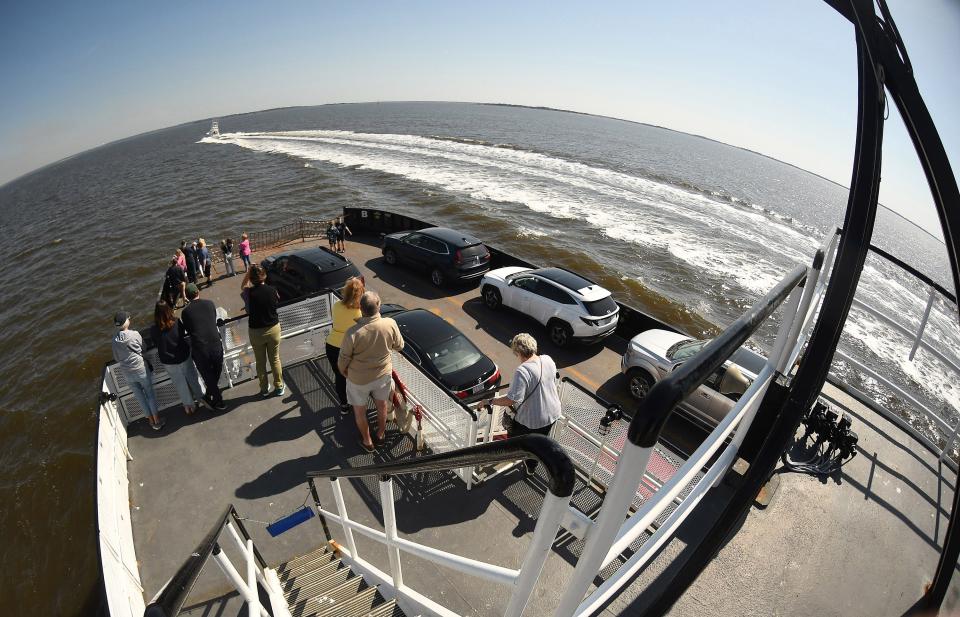
‘It’s about providing a service’
But as the region’s population surges and the Cape Fear region continues to be “discovered” by visitors and travel writers, most recently having been declared the top “Southern city on the rise” by Southern Living, are the route’s two 40-vehicle ferries, each of which is pushing 25 years old, enough to meet future requirements?
And then there’s the larger economic question of whether the DOT and legislators will continue to support subsidizing money-losing ferry routes. According to a 2009 N.C. State study, passenger revenue covers only about 6% of the ferry division’s costs.
The Fort Fisher route, one of three tolled ferries out of seven routes in the state’s ferry network, started in the mid-1960s as a public toll ferry. A one-way ticket for a car on the 3.5-mile-long crossing is $7. A passenger ticket on the private Southport-Bald Head Island ferry, which also runs across the Cape Fear River and has its terminal nearly adjacent to the public ferry, is $23.
But public roads don’t physically pay for themselves. Neither does a bridge, multi-use trail, bus station, or many other modes of transportation. Why should a ferry, which by many is seen as a marine highway, be seen differently, said state Rep. Charlie Miller.
“It’s not about making money,” said the Southport Republican, who represents constituents on both sides of the popular ferry crossing. “It’s about providing a service. Sometimes you just have to do something like that to help your residents and your local businesses.”
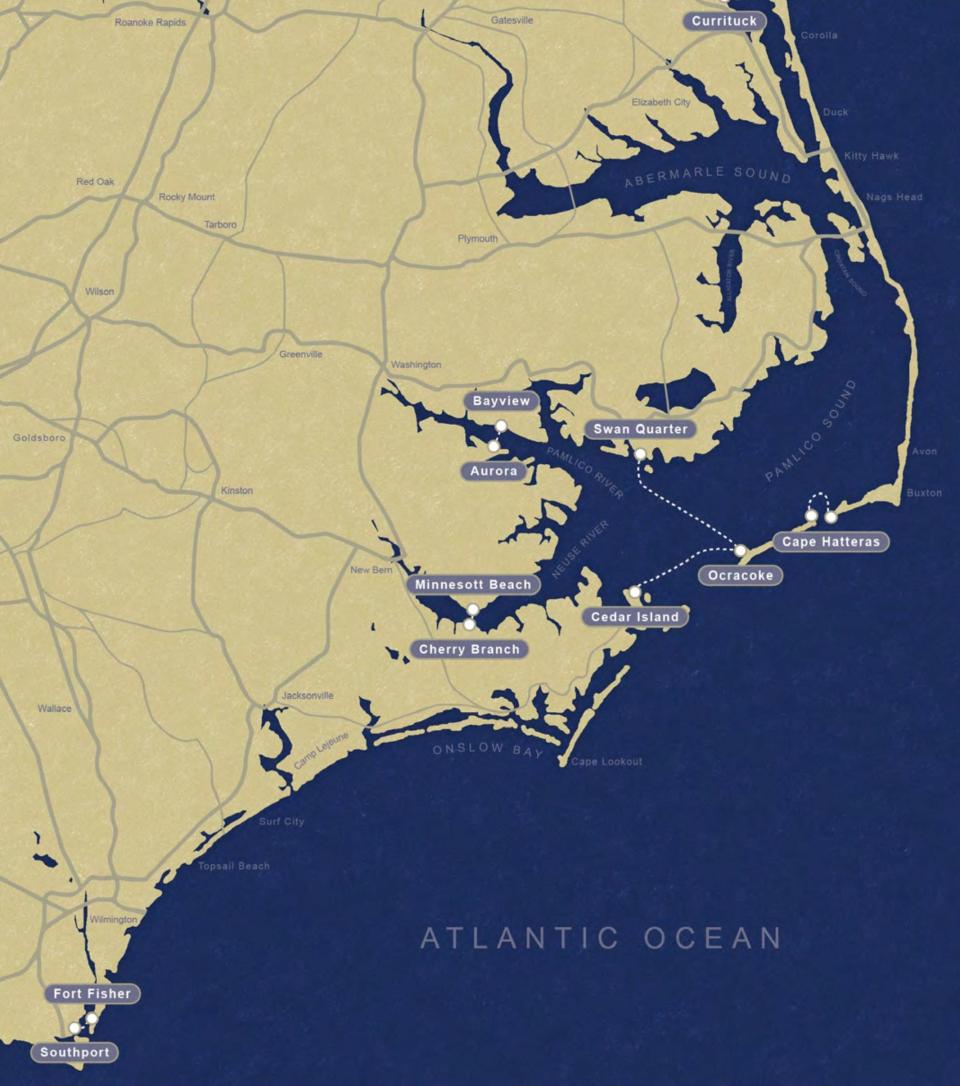
Growing popularity?
But as Southeastern North Carolina continues to develop as one of the fastest-growing metros in the country, and with little chance of a new bridge being built south of Wilmington, will the current ferry boats and terminals be able to handle an increased traffic volume?
According to ferry officials, the DOT is constantly evaluating traffic numbers to make sure they have enough capacity to meet current and future demands. The agency also has proposed two new ferries and further ramp improvements for the Fort Fisher route’s terminals, but there are many more projects in the state’s proposed long-range transportation plan than available funding − as backers of a new Cape Fear Memorial Bridge know all too well.
The lagging increase in transportation infrastructure, especially when it comes to a new river crossing, comes as the region’s population continues to spike.
Carolina Beach’s population has increased from 5,100 in 2000 to more than 7,000 in 2024. Across the river, St. James has seen its number of residents increase from less than 1,000 in 2000 to an estimated 8,100 this year. And the two towns aren’t the only communities in the Cape Fear region that have experienced massive growth in recent decades − growth that shows little sign of abating in coming years. Projections show the Wilmington-area’s three county region growing from roughly 436,000 residents in 2020 to more than 615,000 by 2040.
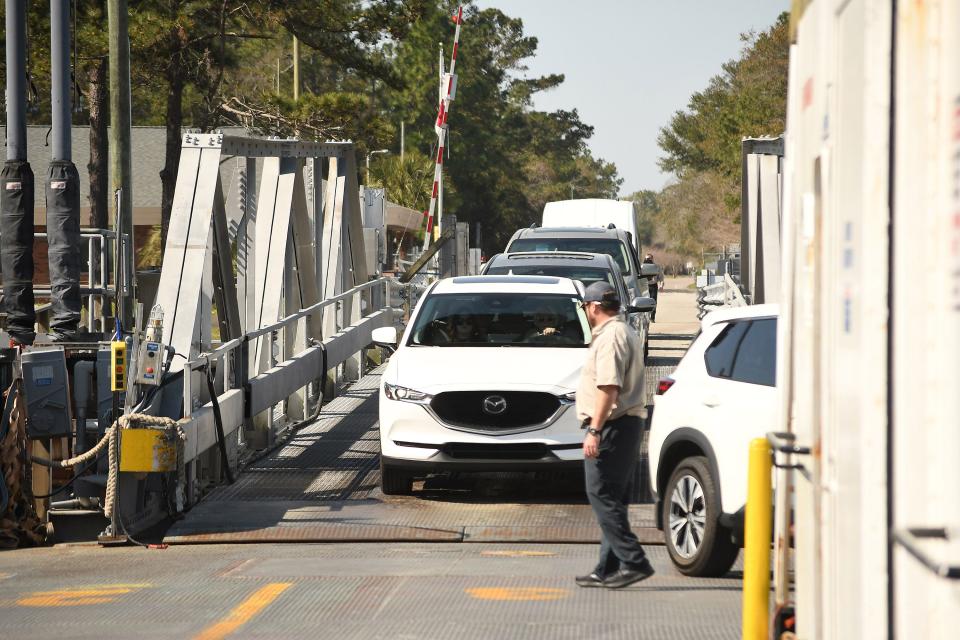
With the Memorial Bridge nearly 35 miles up the road from Southport, the ferry is a vital transportation link for residents of southern New Hanover County and southeastern Brunswick County looking to travel across the river for work or to shop without enduring a roundtrip detour that can easily top 100 miles.
Miller knows that all too well.
“It’s an hour and 20 minute drive from my house to Kure Beach Town Hall. I know that because I have to do it when the ferry gets busy,” he said with a laugh, noting that sinking feeling you get when you’re the 41st car in line for a 40-vehicle ferry.
Miller said he believes the ferry route could support bigger boats and more runs, especially during the busy summer months.
“I’m not sure where the money would come from, but you know it’s just going to get busier and busier considering the growth we’re seeing on both sides of the river,” he said.
|
Year |
Vehicles |
Passengers |
|
2023 |
176,930 |
473,315 |
|
2022 |
176,022 |
475,358 |
|
2021 |
181,221 |
491,383 |
|
2020 |
63,320 |
155,436 |
|
2019 |
169,776 |
450,855 |
|
2018 |
185,895 |
487,894 |
|
2017 |
206,294 |
549,962 |
Plug and sail
But ferry routes aren’t like roads. The fixed annual costs are much higher than a new lick of asphalt every few years, maintaining drainage structures, and the occasional landscaping and mowing. Besides construction and operating costs of the vessels themselves, you have crew costs and maintenance of the terminals on either side of the river.
According to a March 1 report from the DOT ferry division, the cost of operating the Fort Fisher-Southport ferry between July and December − roughly half a fiscal year − was just over $4 million. That was less than half the cost of operating the Hatteras Inlet ferry, which runs between Hatteras and Ocracoke islands on the Outer Banks, over the same time period.
Increasing tickets prices to generate more revenue might not be politically feasible, especially if the ferry routes are viewed as waterborne roadways and a vital infrastructure link by residents.
But another long-term idea that has been researched in Raleigh and could help lower operating costs over the long term is electrifying at least part of the state’s ferry fleet.
Decarbonizing sectors of the state’s economy by transitioning them to cleaner fuel sources has been a key goal of Gov. Roy Cooper, with much of the focus during his time in office on “greening” the energy sector by phasing out greenhouse gas-spewing coal plants in favor or cleaner energy sources. But the state’s transportation sector is a bigger and arguably easier and cheaper way of quickly reducing the emission of climate-warming gasses into the atmosphere.
According to the state’s latest greenhouse gas inventory report, 36% of North Carolina’s greenhouse gases are emitted by cars, trucks, busses, boats, and other transportation-related uses. As a branch of state government, it makes sense for the DOT to look at ways to make North Carolina’s ferries “greener.”
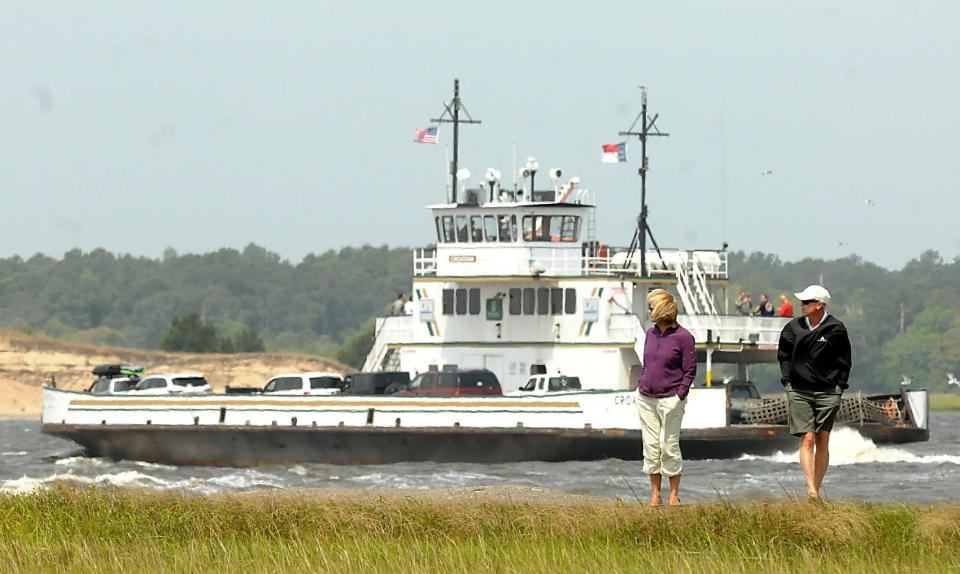
But charging up a vehicle-carrying ferry isn’t quite the same as plugging an electric vehicle into a garage-based home charger.
The upfront costs are significant, both for building new electric-powered vessels and upgrading the terminals with the power connections.
Along with a ride that’s better for the environment, electric ferries have several advantages over traditionally powered vessels. Operation and maintenance costs are substantially lower, largely due to much lower fuel and maintenance costs, and would add up quickly over a multi-decadal life of a new ferry. The passenger experience, in the form of a quieter ride, also shouldn’t be discounted.
“The ferry division recently completed a high level investigation into electric ferries for several routes,” said DOT spokesman Tim Hass in an email. “The division is continuing its effort to research and plan for electrification.”
Beyond the dollar signs
While the ferry might not pay for itself, Miller, who is a lifelong Southport resident, said it still has a sizeable impact on nearby communities.
He said you can tell when the ferry has arrived in Southport because the town’s streets fill up, quickly followed by the town’s shops and restaurants.
“It has a significant economic impact, and you can just see that,” he said.
According to a 2020 study by the Institute for Transportation Research and Education (ITRE) at N.C. State University, the Southport ferry has an annual economic output of more than $135 million. It also generates $4.6 million in annual transportation benefits, which includes vehicle costs savings and travel time benefits.
“Ultimately, the N.C. Ferry System is a source of job creation, local revenue and tax creation that benefitsthe coast and the state,” the report states. “It provides economic and quality-of-life benefits for its ferry passengers accessing communities along the state’s extensive coastline.”
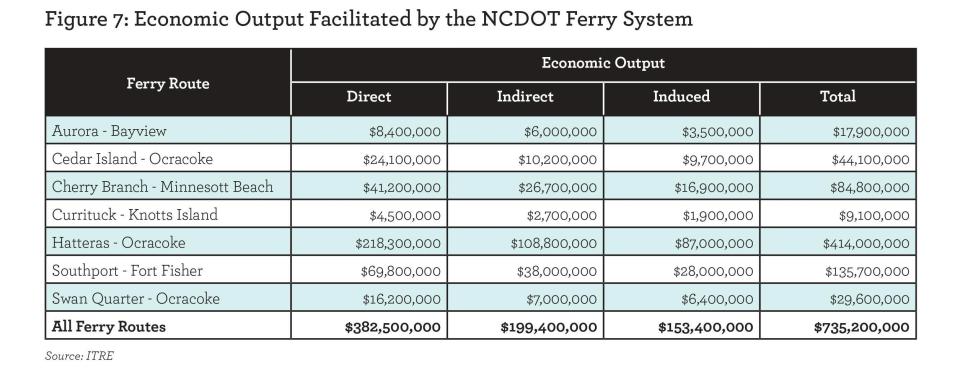
Besides attracting tourists − and their dollars − to the nearby coastal communities and attractions, the ferry also draws plenty of commuters. For them, the ferry isn’t simply a nice excursion to do with visiting friends and family.
One of those is Deyanira Romo Rossell, communications manager at the N.C. Aquarium at Fort Fisher.
As an Oak Island resident, taking the ferry to the Fort Fisher for work saves her a long drive up and down both sides of the Cape Fear River − one that would be even worse these days thanks to the lane closures taking place on the Memorial Bridge.
After growing up in rural Texas, Rossell said she doesn’t miss long drives. And then there’s the experience of riding the ferry.
“We see fishing boats, big boats, sunrises and even sunsets depending on which boat we catch back,” she said. “It’s very relaxing.”
Along with offering the aquarium’s Brunswick-based staff and volunteers a nice commute to work, Rossell said the ferry also is an important link in allowing visitors to access the popular attraction at the southern tip of New Hanover County. Last year was the busiest year ever for the aquarium, with more than 502,000 visitors passing through the doors of the Fort Fisher site, besting the previous top year of 2017 by more than 18,000 guests.
Rossell added that she also enjoys interacting with the ferry crewmembers, many of which she knows and know her, and sometimes tourists as they enjoy riding the waves. And it offers her a chance to catch up on the news, her audiobooks or even get in a quick nap.
“It’s just a really pleasant part of my job,” she said.
Heating up
As the weather gets warmer, the number of vehicles using the Fort Fisher-Southport ferry tends to go up, according to the N.C. Department of Transportation.
|
January |
2023: 13,154 |
2024: 14,406 |
|
February |
2023: 8,457 |
2024: 12,652* |
|
March |
2022: 12,367 |
2023: 13,800 |
|
April |
2022: 17,952 |
2023: 17,306 |
|
May |
2022: 17,396 |
2023: 16,192 |
|
June |
2022: 22,619 |
2023: 21,391 |
|
July |
2022: 23,567 |
2023: 24,593 |
|
August |
2022: 20,518 |
2023: 20,353 |
|
September |
2022: 16,095 |
2023: 15,291 |
|
October |
2022: 14,246 |
2023: 15,007 |
|
November |
2022: 10,751 |
2023: 9,478 |
|
December |
2022: 8,505 |
2023: 8,434 |
Reporter Gareth McGrath can be reached at [email protected] or @GarethMcGrathSN on X/Twitter. This story was produced with financial support from the Green South Foundation and the Prentice Foundation. The USA TODAY Network maintains full editorial control of the work.
This article originally appeared on Wilmington StarNews: As Wilmington continues to grow, is Southport-Fort Fisher ferry ready?
EMEA Tribune is not involved in this news article, it is taken from our partners and or from the News Agencies. Copyright and Credit go to the News Agencies, email [email protected] Follow our WhatsApp verified Channel









